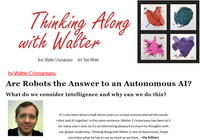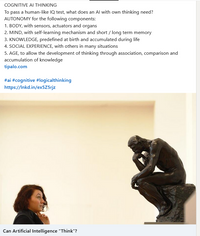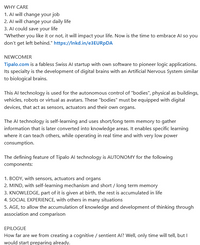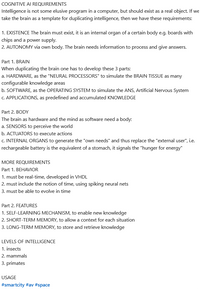Tipalo® - acronym for Time based pattern logic
COGNITIVE AI will drive the next industrial revolution and the colonization of space.
COGNITIVE AI REQUIREMENTS
Intelligence is not some elusive program in a (super)computer, but should exist as a real object/subject. If we take the biological brain as a template for duplicating intelligence, then we have the following requirements:
1. EXISTENCE The brain must exist, it is an internal organ of a certain body. The brain should be an "internal" object of a given body, e.g. boards with corresponding chips and a power supply.
2. AUTONOMY via own body The brain needs information to process and give answers.
SENSORS are needed to perceive the world
ACTUATORS are required to execute actions
INTERNAL ORGANS are for a certain purpose: to generate the "own needs" and thus replace the "external user", i.e. rechargeable battery is the equivalent of a stomach, it signals the "hunger for energy"
ASSUMPTIONS VS EXPECTATIONS
Our egocentric way of "judging" others makes it impossible for us to evaluate our own thinking. We "assume" that an AI should be as intelligent as an educated adult in his forties, preferably an all-rounder. But how do we measure intelligence in people? By means of an IQ test, where the answers are evaluated by a set of questions based on the age of the test person, which means that intelligence develops in time.
COGNITIVE AI THINKING
To pass a human-like IQ test, what does an AI with own logical thinking need?
The Tipalo Human Mind Hierarchy Model allows AUTONOMY for the following components:
1. BODY, with sensors, actuators and organs
2. BRAIN, with self-organizing spiking neural nets
3. MIND, with self-learning mechanism and short / long term memory
4. KNOWLEDGE, part of it is given at birth, the rest is accumulated in life
5. SOCIAL EXPERIENCE, with others in many situations
6. AGE, to allow the accumulation of knowledge and development of thinking through association and comparison
WHAT IS INTELLIGENCE?
INTELLIGENCE IS THE LOGICAL ADAPTATION OF THE BEHAVIOR OF
AN AUTONOMOUS PHYSICAL ENTITY THROUGH ITS OWN DECISIONS USING VIRTUAL MEANINGS
DERIVED FROM ITS KNOWLEDGE COMBINED WITH THE FEEDBACK OF ITS EXPERIENCE TO SURVIVE
Company overview
INTRODUCTION
Tipalo GmbH is a Swiss LLC near Zurich, a fabless AI startup with own software to pioneer logic applications.
We develop COGNITIVE AI as digital brains with an Artificial Nervous System similar to biological brains.
Our AI technology is used for the autonomous control of "bodies", physical as buildings, vehicles, robots or virtual as avatars.
These "bodies" must be equipped with digital devices, that act as sensors, actuators and their own organs.
AI APPROACH
Our AI technology is self-learning by collecting information that is later converted into knowledge areas.
The Tipalo approach to AI is very simple: we take biological intelligence as a template, means the living brain.
It needs a different mindset to comprehend and represent parts of the real world and replicate the human mind.
Our understanding of intelligence is based on logic, our AI concept contains objects reacting in time and space.
Tipalo COGNITIVE AI as digital brain can control any type of connected body, real or virtual
EDGE AI USE CASES
Tipalo target market is COGNITIVE AI, a brain for a corresponding body and performing intelligence for:
Level 1, as managers for smart buildings + robots for indoor manufacturing and outdoor surveillance
Level 2, as pilots for autonomous vehicles of any kind, e.g. terrestrial, naval, aeronautics, space
Level 3. as autonomous robots, e.g. for workers in hazardous environments, for avatars in virtual landscapes
CLOUD AI FOR TELEPRESENCE
Tipalo brains can be connected via Internet to any embedded system or robot body, real or virtual,
by using a connection with high bandwidth and low latency enabling real-time, like 5G or fiber glass,
Furthermore, the accumulated experience of many individual brains can be aggregated on demand,
enabling a collective knowledge database for a certain body type, e.g. autonomous vehicles
Tipalo AI - technology characteristics
ACTUAL PROCESSING
Tipalo AI is used in real-time, using very low working frequency paired with very low power consumption.
1. Real-time processing, where the reaction time of the digital brain is 1K faster then the biological brain
2. Working frequency is at 50 MHz, while using direct VHDL implementation for concurrent processing
3. Power consumption is less than 100 W, using high capacity FPGA SiP with on-chip integrated HBM2
FUTURE PROCESSING
Tipalo AI intends to migrate the implementation from FPGA with HBM2 to own ASIC
1. The ASIC will be manufactured using FD-SOI technology, enabling radiation resistant chips, i.e. 22FDX
2. The ASIC will use only persistent memory, eliminating any type of volatile memory, i.e. SRAM, DRAM, etc.
3. The used emerging persistent memory will also be radiation resistant, i.e. MRAM, CeRAM, 1T FeFET, etc.
The unique and defining feature of Tipalo AI technology is AUTONOMY, at 3 levels
Level 1. BODY
The body is the first decisive argument for autonomy, as it enables to do everything on its own.
Cognitive AI requires a body hardware with sensors, actors and internal organs, like any living entity.
Level 2. MIND
Next level of autonomy are spiking neural nets, using distinct groups enabling interactive algorithms.
This implies that only some neurons are needed for a specific purpose, allowing explainable AI.
Level 3. KNOWLEDGE
Another level of autonomy is the software, as synapses between neurons, which implies no code.
Synapses are used as universal format for any purpose and enable the accumulation of knowledge.
Tipalo AI - technology description
AI IMPLEMENTATION
Tipalo AI enables the simulation of different brain regions in real-time, all the time and stand alone,
while being connected to a certain body hardware, which is equipped with sensors, actors and organs.
The VHDL implementation of our AI model allows massive parallel execution, without any processors.
This implies we do not use any math/statistics/algorithms, while no bias/training/inference is required.
AI KNOWLEDGE
We use 3 intelligence levels, which have a template in nature: insects, fishes/mammals/birds and primates.
They reflect the amount of neurons and their synapses, from 1M with 16, via 1G with 256, to 10G with 1K.
Each level has predefined knowledge, to manage the body and the mind, together with some genetic memory.
The AI explores autonomously the environment and stores its own experience as accumulated knowledge.
AI PLATFORM FOR DIGITAL BRAINS
Tipalo develops strong AI with cognitive features creating hereby digital brains with:
1. Real-time operating system in VHDL, enables simulation of brain tissue via Programmable Neural Nets (PNN)
2. Self-Learning Mechanism (SLM) enables knowledge accumulation using Self-Associative Memory (SAM)
3. Artificial Nervous System (ANS), contains the brain landscape as map of all synapses, see connectome
AI LIBRARIES FOR NEURAL COMPONENTS
Tipalo develops AI libraries with configurable reference designs based on PNNs for different ANS levels as:
1. Neural drivers for interfacing sensors, actors and organs of any kind, e.g. visual, limbs, rechargeable battery
2. Neural applications for various knowledge areas using SLM, e.g. identification, locomotion, task workflows
3. Neural storage for different memory types based on SAM, e.g. short-, mid- and long-term memory
AI COMMUNICATION
Tipalo AIs can connect with each other, via cable or wireless, to communicate for several purposes:
1. positive identification, to enable the coordination of their actions for a possible common task
2. certain interaction, to enable the extension of knowledge by teaching each other new things
3. direct exchange, to enable the aggregation of information for a certain area of knowledge
Published articles
Tipalo information as slideshow










